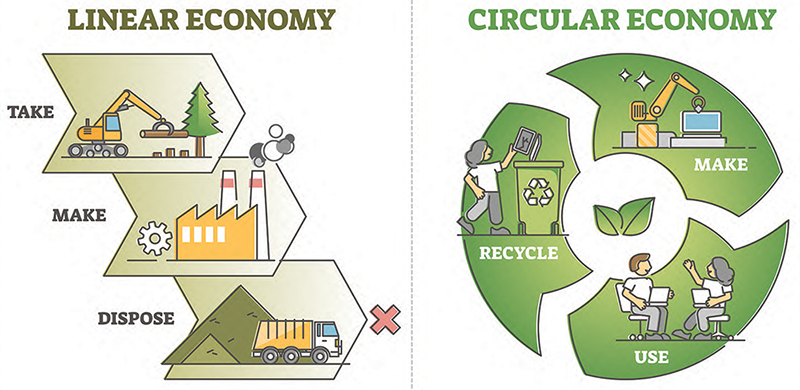Welcome to Circular Economy 101! Circularity is essential to helping us achieve our 2030 Sustainability Targets. It plays an important role in how we live our daily lives, protect planet Earth by reducing waste and emissions, and prolong our future for upcoming generations.
Recycling, upcycling, circular economy, closing the loop, and carbon neutrality are all buzzwords we come across in the context of sustainability. What does it mean to close the loop? What is circularity? And how does it help? Let’s find out!
Circularity is the idea that materials and products in the economy do not have an end (i.e. they do not become waste). Instead, after use, they are cycled back into the market for continuous use.
- Most of the world is based on a linear economy where resources are taken from the earth, products get made, and then we dispose of it as waste after use (take, make, waste model).
- In a circular economy, items are made, used for as long as possible, collected for recycling or reuse, processed, and made again using already-existing products and byproducts.

Not only does a circular cycle eliminate waste, but it provides the additional benefit of adding more sustainable resources to the economy. In a circular economy, fewer virgin or new natural resources need to be extracted because these used materials are already available for use again. This is a 1-for-1 replacement.
There is also an exponential benefit to leaving natural resources in their original form and place.
- More mature natural resources are, in a sense, stronger and provide exponentially more of their natural benefit to the system, or, for each year a natural resource is left in place, more benefits are provided than the previous year. Think of a larger tree providing more oxygen than a smaller tree.
- Additionally, leaving natural resources where they naturally exist allows them to continue their natural ecosystem benefit with no human resources needed to extract them. Think of eliminating the need to use energy from a chainsaw to cut a tree down.
A circular economy, or the concept of circularity, is inspired by nature. The natural lifespan and process of organic products made from plants, minerals, and animals is also a cycle. By embracing the principles of circularity, we can create a sustainable future that aligns with the regenerative patterns found in nature.
- For example, plants grow, develop, decompose, and renourish the soil for new plants to grow.
In our current global linear economy model, items are made to be disposed of; whether it’s a single-use fork or a favorite pair of shoes. For a circular economy to work, products need to be designed for circularity.
- Products should be kept in use at their highest value for as long as possible. This means using a car or phone until it’s no longer working rather than when a new style is brought to market.
- Technical parts can be broken down and eventually recycled but breaking it down, and the process of recycling takes energy.
- Additionally, there is more value in a working car or phone than there is in a piece of metal. Before placing the responsibility on consumers, these products need to be designed and manufactured for long-lasting use.
- Circularity is good for business because it supports high-value products rather than high-cost and inefficient processes.
To learn more, take some time to watch this video by Ellen MacArthur on the basics of the circular economy (YouTube), which explains these concepts.

